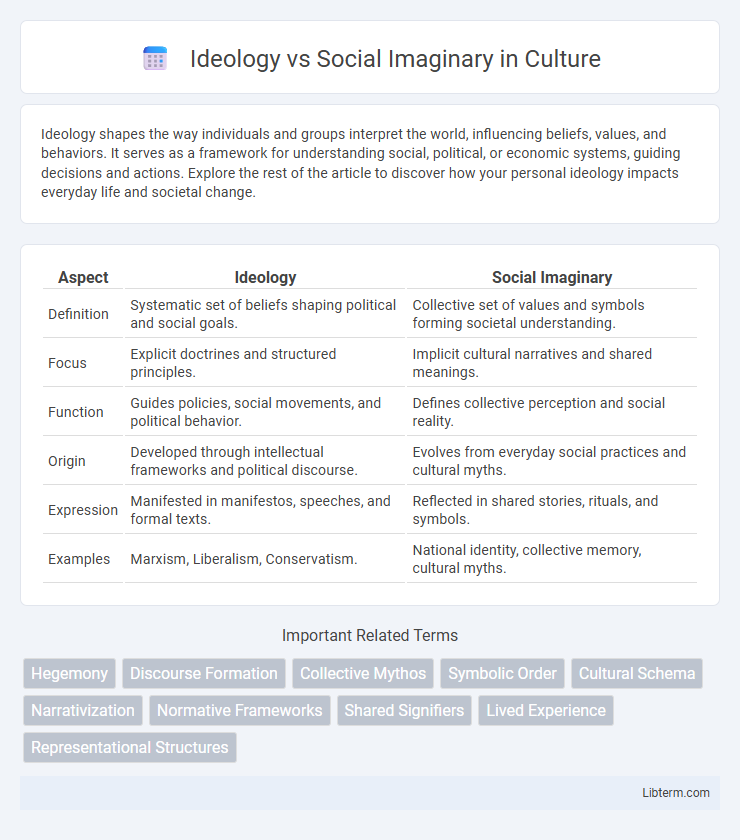Ideology shapes the way individuals and groups interpret the world, influencing beliefs, values, and behaviors. It serves as a framework for understanding social, political, or economic systems, guiding decisions and actions. Explore the rest of the article to discover how your personal ideology impacts everyday life and societal change.
Table of Comparison
| Aspect | Ideology | Social Imaginary |
|---|---|---|
| Definition | Systematic set of beliefs shaping political and social goals. | Collective set of values and symbols forming societal understanding. |
| Focus | Explicit doctrines and structured principles. | Implicit cultural narratives and shared meanings. |
| Function | Guides policies, social movements, and political behavior. | Defines collective perception and social reality. |
| Origin | Developed through intellectual frameworks and political discourse. | Evolves from everyday social practices and cultural myths. |
| Expression | Manifested in manifestos, speeches, and formal texts. | Reflected in shared stories, rituals, and symbols. |
| Examples | Marxism, Liberalism, Conservatism. | National identity, collective memory, cultural myths. |
Introduction to Ideology and Social Imaginary
Ideology represents a structured set of beliefs and values that shape individual and collective behavior within social, economic, and political contexts, influencing power dynamics and maintaining societal order. Social imaginary encompasses the shared symbols, narratives, and practices that enable communities to understand their social existence and create collective meaning beyond formal doctrine. Understanding the distinction between ideology and social imaginary clarifies how explicit belief systems contrast with the underlying, often unconscious frameworks that guide societal interactions and cultural norms.
Defining Ideology: Core Concepts
Ideology consists of structured beliefs and values shaping political and social perceptions, often serving to justify power dynamics within societies. It functions as a framework guiding individual and collective actions by providing interpretations of reality aligned with specific interests. Core concepts of ideology include doctrine, hegemony, and false consciousness, which explain how dominant groups maintain influence through controlling ideas and norms.
Social Imaginary: Meaning and Significance
The social imaginary encompasses the collective set of values, symbols, and shared understandings that shape how communities perceive and organize their social realities. It extends beyond ideology by incorporating cultural myths, collective narratives, and everyday practices that sustain social cohesion and identity. Recognizing the significance of the social imaginary helps explain how societies create meaning and maintain social order through common beliefs and interpretive frameworks.
Historical Development of Ideology
The historical development of ideology reveals its roots in the Enlightenment era, where thinkers like Marx and Hegel formalized it as a systematic body of ideas influencing political and social structures. Ideologies evolved to function as frameworks that justify power relations and guide collective identities, contrasting with social imaginaries, which represent the shared, often implicit, symbols and meanings shaping everyday social life. Over time, ideology became a tool for both social control and resistance, embedded in discourse and institutions, reflecting changing historical contexts and material conditions.
Evolution of Social Imaginary in Society
The evolution of social imaginary reflects collective frameworks through which societies perceive reality, shaping norms, values, and social practices beyond rigid ideological doctrines. Social imaginary evolves dynamically, influenced by cultural narratives, technological advancements, and shared symbols that bind communities in a common understanding. This continuous transformation allows societies to adapt to change, redefine identity, and negotiate power structures in ways that transcend ideological boundaries.
Differences between Ideology and Social Imaginary
Ideology consists of structured sets of beliefs and values that guide political or social behavior, often promoting specific agendas and power relations. Social imaginary refers to the collective understanding, symbols, and narratives through which communities make sense of their social existence and identity. While ideology is explicit and prescriptive, the social imaginary operates implicitly as a shared cultural framework shaping perceptions and social practices.
Interactions and Overlaps: Where They Converge
Ideology and social imaginary converge in shaping collective beliefs and social practices through shared symbols and narratives that influence group identities. Both frameworks interact by framing societal norms and power structures, creating a dynamic interplay where ideological doctrines are embedded within the broader cultural imagination. This overlap facilitates the reinforcement of social cohesion while also enabling contestation and transformation of dominant worldviews.
Influence on Culture and Collective Identity
Ideology shapes culture by providing structured belief systems that guide social norms, values, and political behaviors, embedding power dynamics within collective identity. Social imaginary encompasses the shared symbols, practices, and narratives that evolve organically, creating a sense of belonging and communal understanding beyond formal doctrines. Together, ideology and social imaginary interact to influence cultural cohesion and the formation of collective identity, where ideology often formalizes the implicit meanings sustained by the social imaginary.
Political and Social Implications
Ideology serves as a structured set of political beliefs that guide individual and collective actions, influencing power dynamics and policy-making processes in society. Social imaginary encompasses the shared symbols, narratives, and practices that shape how communities understand their social existence and political legitimacy. The interaction between ideology and social imaginary impacts societal cohesion, political mobilization, and the legitimacy of institutions within diverse cultural contexts.
Conclusion: Ideology vs Social Imaginary in Modern Context
Ideology operates as a systematic framework of beliefs shaping political and social actions, often anchored in power structures and explicit doctrines. Social imaginary, however, reflects the shared symbols, narratives, and collective understandings that create a community's lived reality beyond formal ideology. In the modern context, analyzing the dynamic interaction between ideology and social imaginary reveals how cultural meaning-making influences political legitimacy and social cohesion, driving transformations in public consciousness and institutional practices.
Ideology Infographic

 libterm.com
libterm.com